AN-1266: Autonomous Shock Event Monitoring with the ADXL375
Introduction
According to Piersol and Paez in Harris' Shock and Vibration Handbook, shock is defined as a dynamic excitation of a physical system with a relatively short duration as compared to the time required for the system exposed to that excitation to fully respond (see the References section).
In the Vibration and Shock Handbook, also listed in the References section, DeSilva states that shock occurs when a force, a position, a velocity, or an acceleration is abruptly modified and creates a transient state in the system considered. Shock is a vector with both magnitude and direction.
Accurate shock information can be valuable in a wide range of applications, such as profiling the usage of leased assets or sensitive equipment, shipping data loggers, and accounting for motion artifacts caused by high-g events. In contact sports, biking, or in the military, crash or impact metrics (such as magnitude, point of contact, and direction) can be used by doctors to better diagnose concussion or head trauma resulting from accidents.
To effectively embed a measurement system in these applications, which are typically portable and battery powered, it is important for the sensor to be a small, 3-axis sensor with low power consumption in addition to offering sufficient dynamic range and the bandwidth to accurately capture the shock events.
This application note describes a technique for autonomously detecting and capturing shock events using a low power, high-g, 3-axis digital MEMS accelerometer with minimal intervention from the host processor. The accelerometer can be programmed to monitor single or double (primary and secondary) shocks along any combination of X, Y, and/or Z axes. In addition, the entire shock profile can be captured for further analysis using an integrated 32 sample memory.
About the ADXL375
The ADXL375 is a 3-axis digital MEMS accelerometer that provides low power consumption (145 µA) and high resolution (98 mg/LSB) measurement up to ±200 g at 1600 Hz bandwidth. The digital output data is formatted as 16-bit, twos complement and is accessible through a SPI (3- or 4-wire) or I2C digital interface.
An integrated memory management system with a 32-level first in, first out (FIFO) buffer can be used to store data to minimize host processor activity and lower overall system power consumption. The ADXL375 is supplied in a 3 mm × 5 mm × 1 mm, 14-lead LGA package.
Monitoring Shock Events
A shock can be characterized by its peak amplitude and pulse width. Shock can be generated by collision, ballistics, launching munitions, tool chatter, and so on. The profile or time history of an impact shock caused by collision is influenced by the contacting surfaces. For example, Figure 1 shows shock pulses generated by dropping a steel fixture onto different surfaces. Alternatively, the shock profile can also be characterized using its frequency spectrum (see Figure 2) and this is useful when setting spectral band alarms.
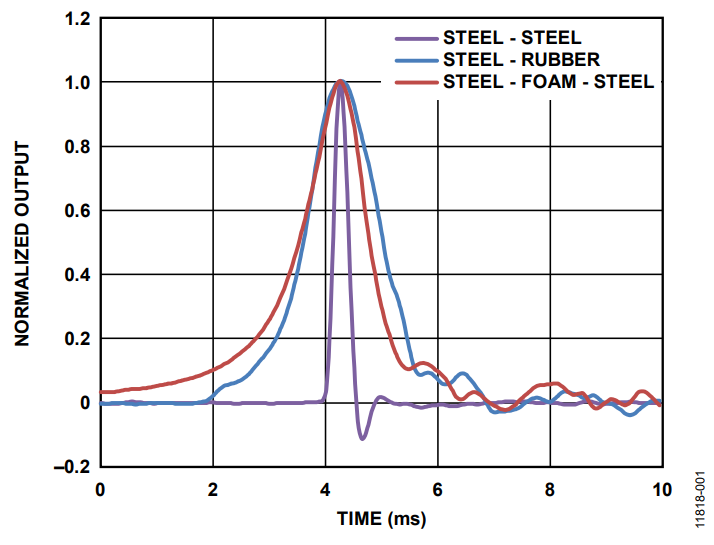
Figure 1. Effect of Impact Interface on the Sharpness of a Shock Pulse.
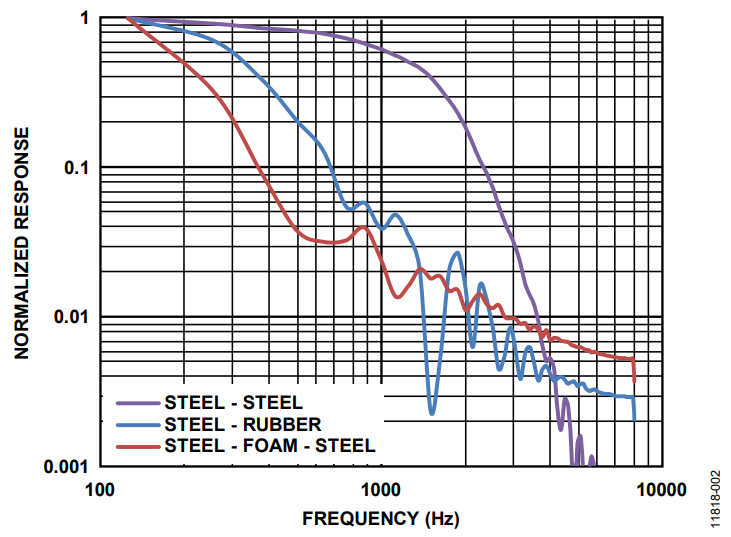
Figure 2. Frequency Spectrum of the Different Shock Pulses.
The ADXL375 provides a way of differentiating and recording shock events of interest based on both amplitude and pulse width. The shock detection function allows users to define a minimum threshold and time duration for the shock. This allows users to distinguish between two shock pulses. Both pulses exceed the minimum threshold setting, but differ in their sharpness.
In addition to the profile, direction can also be an important parameter in determining the severity of a shock event. The ADXL375 allows monitoring of shock events in all 3-axes so that both the profile and direction can be accurately ascertained. Figure 3 shows the accelerometer output when attached to a guided drop fixture and oriented at a 45° angle in the X-Y plane of the package.
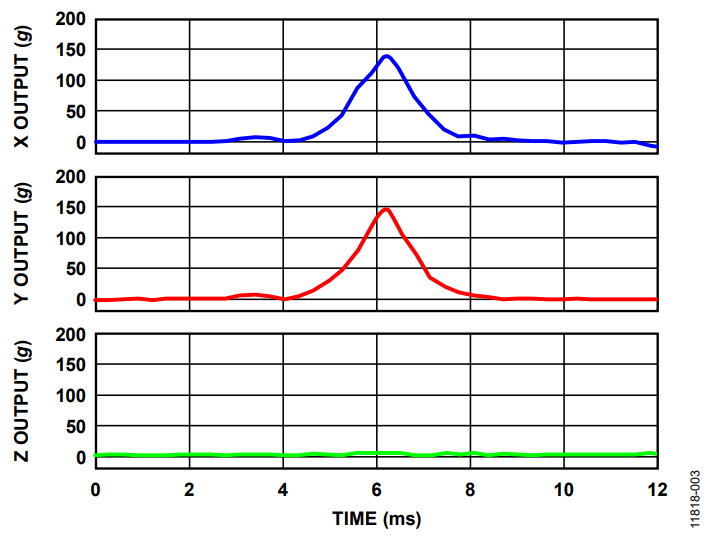
Figure 3. ADXL375 Response to a Guided Drop with the Accelerometer Oriented at 45° in the X-Y Plane.
Detecting Shock Events
The shock interrupt function of the ADXL375 can be used to detect the occurrence of a predefined shock event.
Figure 4 illustrates how the ADXL375 generates an interrupt when a shock event is detected. For detecting a single shock event, the accelerometer uses two parameters: minimum shock threshold (THRESH_SHOCK) and maximum shock duration (DUR). The THRESH_SHOCK register is eight bits in length and contains the unsigned threshold value for generating shock interrupts. The magnitude of the shock event is compared with the value in the THRESH_SHOCK register for shock detection. The resolution of the threshold setting is 780 mg/LSB. The DUR register is eight bits in length and contains an unsigned time value representing the maximum time that an event can be above the THRESH_SHOCK threshold to qualify as a shock event. The time resolution for the shock duration setting is 625 µs/LSB.
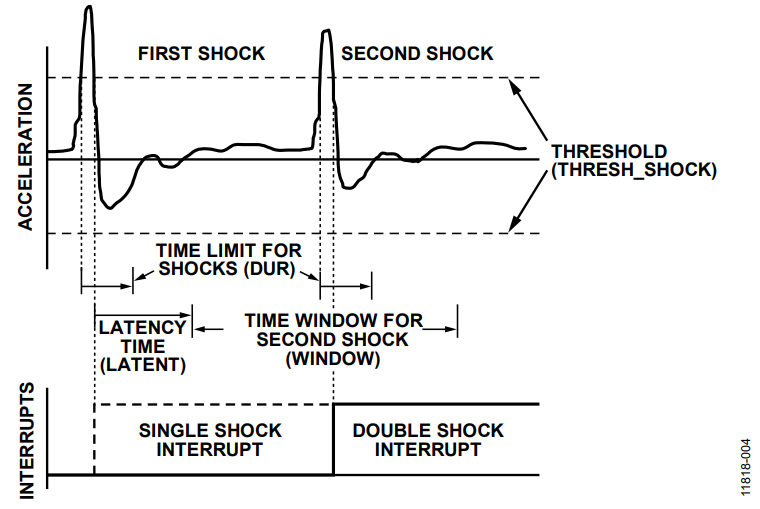
Figure 4. Shock Interrupt Function.
The shock detection function always utilizes undecimated data sampled at 3200 Hz. Lower output data rates (100 Hz to 1600 Hz) are achieved by decimating the internal 3200 Hz sampling frequency. Since the −3 dB bandwidth varies with the output data rate and can be lower than the bandwidth of the undecimated data (1600 Hz), the high frequency and high-g data that is used to determine shock events may not be present if the output of the accelerometer is examined. This may result in a situation where the shock interrupt is triggered, however the output data does not appear to meet the conditions set by the user for the corresponding function as illustrated in Figure 5.
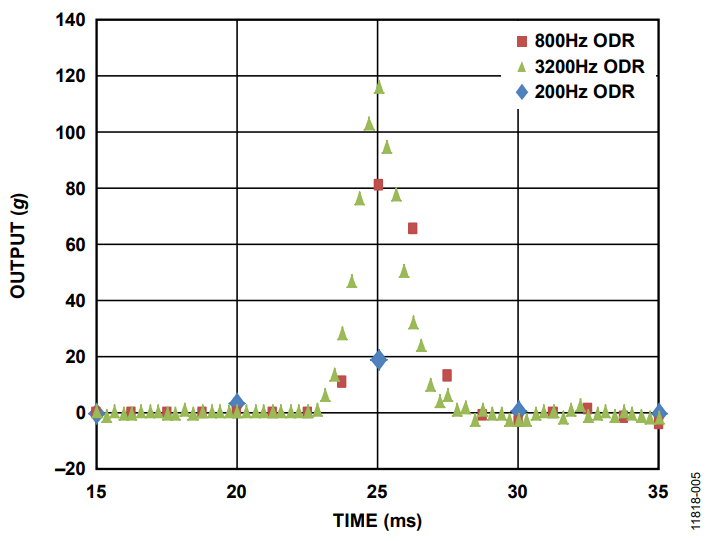
Figure 5. Same Shock Pulse Captured at Different Output Data Rate (ODR). The −3 dB Bandwidth is 1/2 the ODR.
Threshold Setting
Since the shock duration setting has a finite resolution, the threshold value to trigger a shock interrupt should be set as low as possible to effectively differentiate between shock pulses using their pulse width. As shown in Figure 1, the difference in pulse width narrows closer to the peak amplitude. However, noise is also an important consideration when setting the minimum threshold.
Figure 6 shows the X, Y, and Z output noise of the ADXL375 at the undecimated 3200 Hz sample rate. To minimize false positives and be reliably above the noise floor, it is useful to know the peak value of the noise. Peak-to-peak noise can only be estimated statistically assuming a Gaussian noise distribution. For example, the percentage of time that noise will exceed a peak-to-peak value of 8 times the rms value is 0.006%. This corresponds to 2 g or at least 3 LSB. In addition to the accelerometer, any background noise in the application also has to be considered.
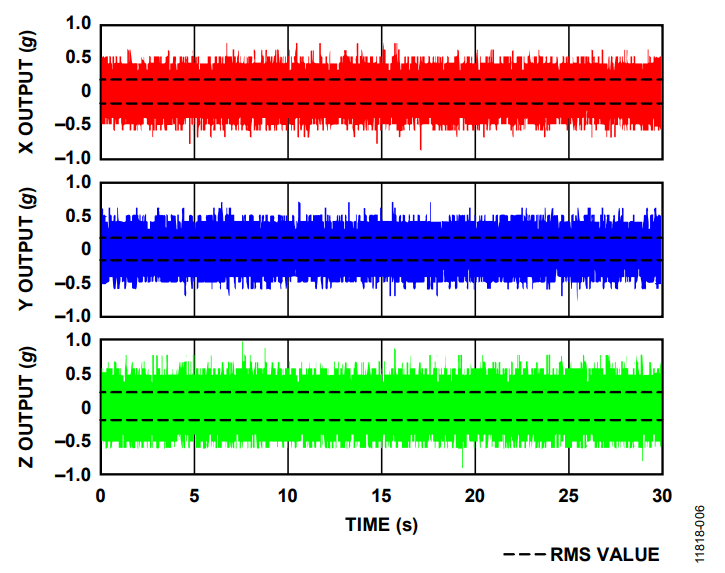
Figure 6. Noise at 3200 Hz Output Data Rate.
In addition to the primary shock event, a secondary event can also be detected using the latency and time window parameters. The latency parameter allows users to set a minimum wait time between shocks during which any additional shocks are ignored even if they fit the predefined profile.
The latent register is eight bits in length and contains an unsigned time value representing the wait time from the detection of a shock event to the start of the time window (specified by the window register) during which a possible second shock event can be detected. The scale factor is 1.25 ms/LSB. Although a second shock must begin after the latency time expires, it need not finish before the end of the time defined by the window register. A value of 0 in the latent register disables the double shock function.
Individual axes can be enabled or disabled from detecting shock events by setting the appropriate bits in the SHOCK_AXES register after enabling the single or double shock interrupt (INT_ENABLE) and mapping them to either the INT1 or the INT2 pin using the INT_MAP register.
If the interrupts are triggered, results are displayed in the INT_SOURCE and the ACT_SHOCK_STATUS registers. Figure 7 shows the appropriate register outputs for a given input shock profile.
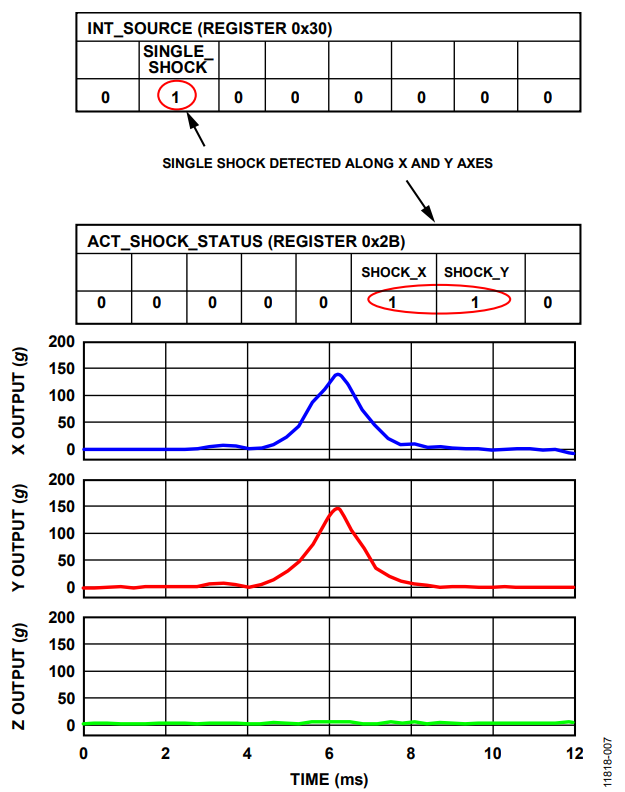
Figure 7. Input Shock Profile and the Corresponding Interrupts. Settings: Threshold = 19.5 g, Duration = 5 ms.
Capturing Shock Profile
In addition to detecting shock events and generating an interrupt, the ADXL375 provides the option of capturing the entire shock profile for further analysis with no intervention from the host processor. This is achieved using the shock interrupt registers in combination with the accelerometer’s internal FIFO. Refer to AN-1025 (see the References section) for a more detailed description of using the FIFO.
The idea is to start saving output samples in memory once a shock event is triggered. Yet, the shock interrupt is triggered only after the output goes below the predefined minimum threshold as illustrated in Figure 4 and this results in the entire shock profile being missed. However, the triggered FIFO mode offers the flexibility of saving samples (up to 32) before the actual trigger event. This can be configured using the FIFO_CTL register.
Ideally, the accelerometer should be set to 3200 Hz ODR to match the sampling of the shock interrupt function. Figure 8 shows the samples stored in the FIFO when set to different pretrigger sample lengths.
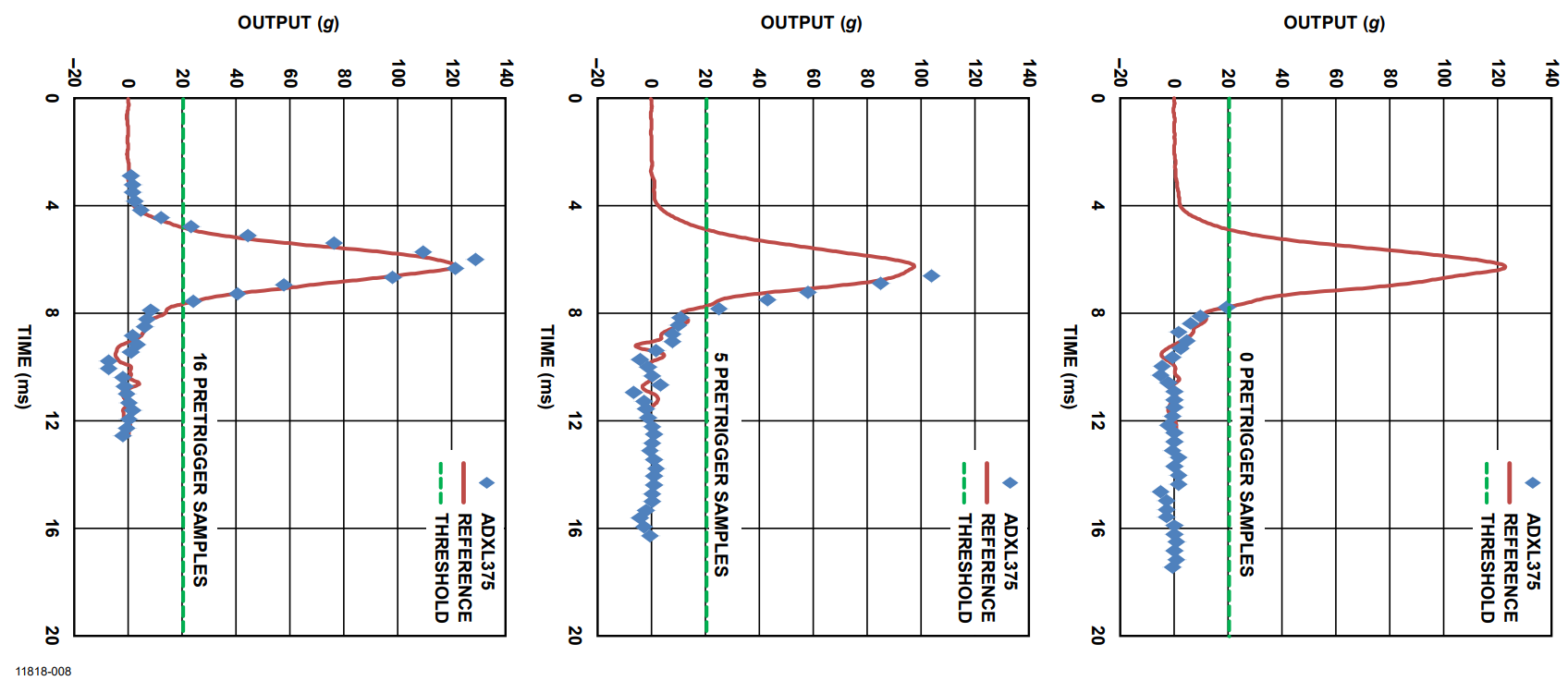
Figure 8. Shock Profile Capture using the Triggered FIFO Mode.
The whole procedure requires no intervention from the host processor other than reading the contents of the FIFO. Without the FIFO operating in the triggered mode, the host processor would continuously poll the accelerometer at 3200 Hz and analyze the results to capture transient events. The ADXL375 offers considerable power savings by letting the processor be in a low power state for the majority of the time especially in applications where shock events are rare and can occur over periods of months or years.
Evaluation Software
The shock monitoring function has also been implemented as part of the evaluation software (EVAL-ADXL375Z-M). Users can experiment with this feature through a graphical user interface.
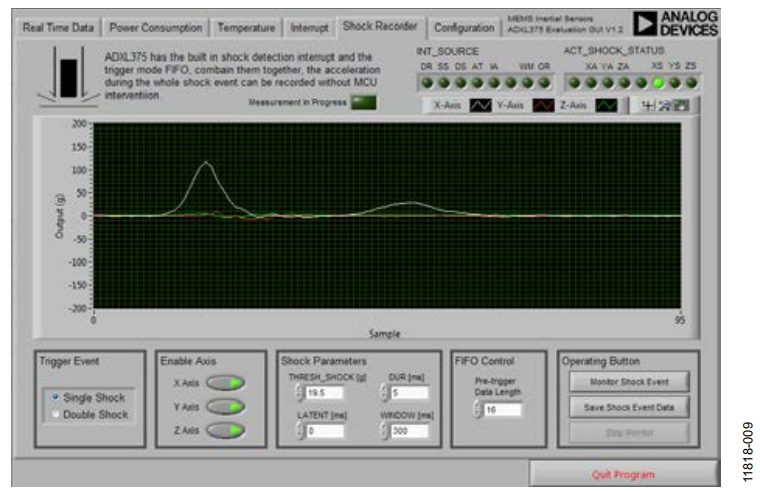
Figure 9. ADXL375 Evaluation Software.
Example Code
This section outlines the procedure for enabling the built-in shock detection and data capture functionality of the ADXL375 for autonomous shock event monitoring and recording. The register values shown in this section can be fine-tuned for individual applications based on the mechanical characteristics of the system, however they provide a good starting point.
- Write 0x28 to Register 0x1D; set shock threshold to 31.2 g.
- Write 0x50 to Register 0x21; set shock duration to 50 ms.
- Write 0x20 to Register 0x22; set latency to 40 ms.
- Write 0xF0 to Register 0x23; set shock window to 300 ms.
- Write 0x07 to Register 0x2A to enable X-, Y-, and Z-axes participation in shock detection.
- Write 0x0F to Register 0x2C to set output data rate to 3200 Hz.
- Write 0x40/0x20 to Register 0x2E to enable single shock or double shock, respectively.
- Write 0x40/0x20 to Register 0x2F to assign single shock or double shock interrupt, respectively, to the INT2 pin.
- Write 0xEA to Register 0x38 to enable triggered mode FIFO. If an interrupt is detected on the INT2 pin, the FIFO records the trigger event acceleration with 10 samples retained from before the trigger event.
- Write 0x08 to Register 0x2D to start the measurement. It is recommended that the POWER_CTL register be configured last.
References
De Silva, C. W. 2005. Vibration and Shock Handbook. CRC Press.
Fisher, Christopher J., Tomoaki Tsuzuki, and James Lee. 2009. “Utilization of the First In, First Out (FIFO) Buffers in Analog Devices, Inc., Digital Accelerometers. Application Note AN-1025. Analog Devices, Inc.
Piersol, A. G. and T. L. Paez. 2009. Harris’ Shock and Vibration Handbook, Sixth Edition. McGraw-Hill Professional.
